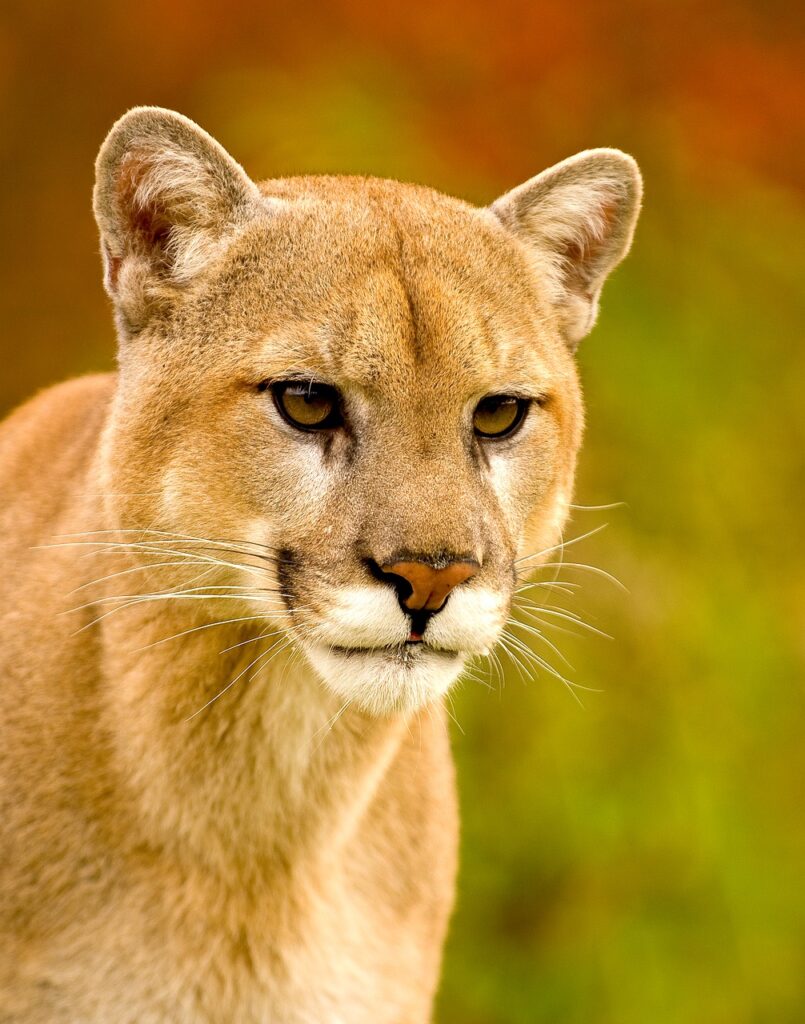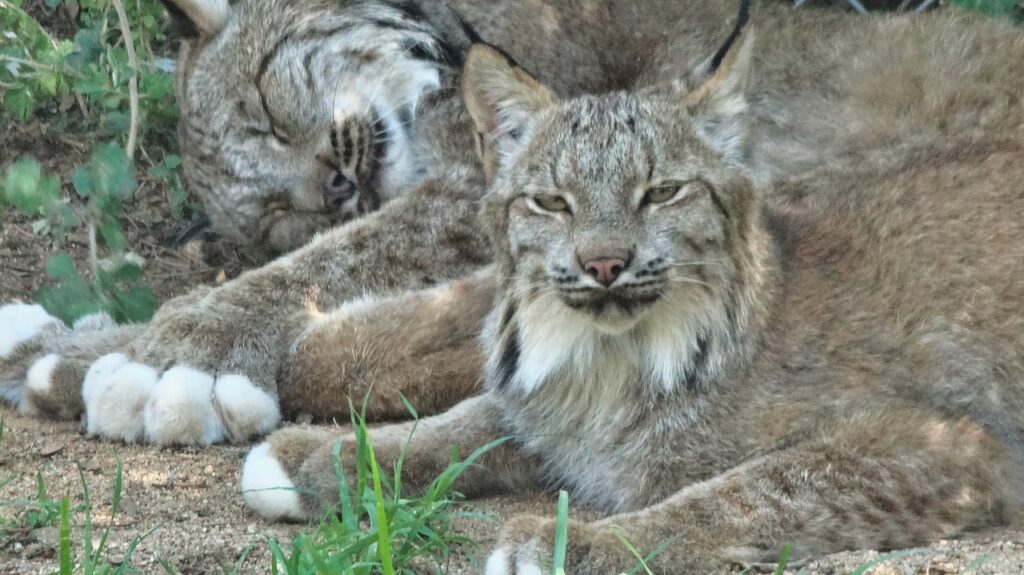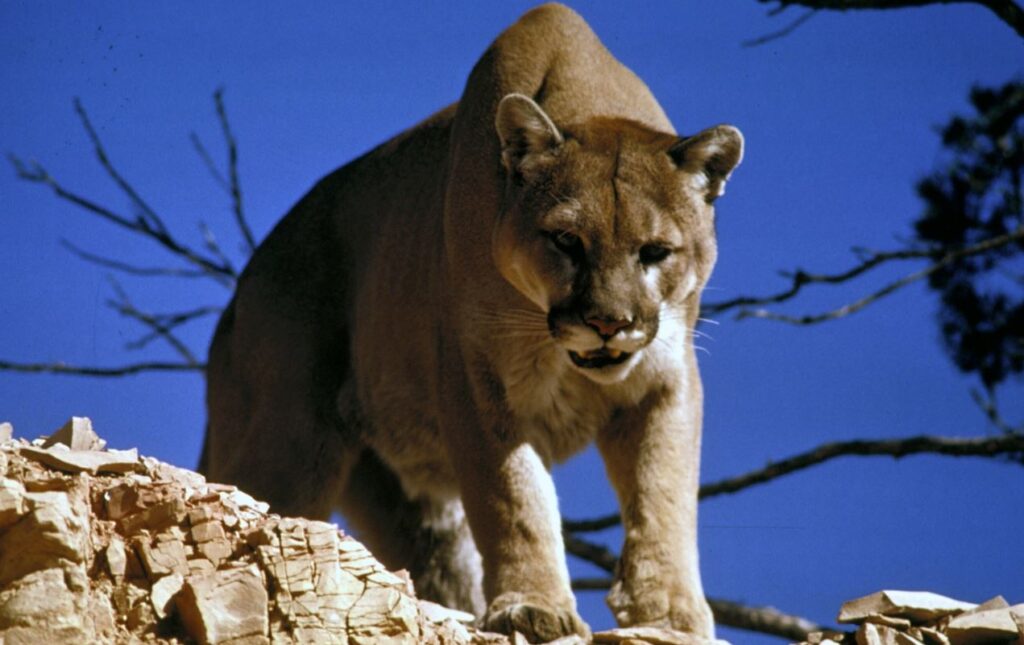What are the Differences Between Mountain Lions and Bobcats?
Although mountain lions and bobcats have quite a few things in common – they both have more than one same for a start – and they are both carnivorous hunters that live in the US, there’s quite a lot of differences between the two animals.
How to tell Mountain Lions and Bobcats Apart
1. Size
Possibly the easiest way to tell a mountain lion and a bobcat apart is the vast difference in their sizes. An adult male mountain lion weighs in at anything between 50-100kg, while females range between 30 and 65kg.

Compared to a mountain lion, a bobcat is much smaller in stature, and males weigh between 6 and 18kg while females are 4-15kg. Mountain lions are also much taller as they stand 60-90cm at the shoulder, while bobcats are only 30-60cm.

2. Location & habitat
Mountain lions generally live in the mountains or areas with steep canyons, although they have been known to live in forest areas and lowlands. Mountain lions are used to cold winters and snowy weather. They live across fourteen western states of the US, and there is a tiny population living in Florida.
Bobcats are highly adaptable animals and can survive in several different habitats – from forests to deserts to coastal areas – and are widely distributed across North America and southern Canada. Bobcats often make dens in hollow logs, tree stumps, caves, and undergrowth.
3. Tail
One of the most easily distinguishable features between mountain lions and bobcats in their tails. Mountain lions have long tails that are around one-third of the length of their bodies. On the contrary, bobcats have a short and stumpy tail, hence the name “bobcat”. A bobcat’s tail is often no longer than 6 or 7 inches.
4. Prey
Mountain lions and lions are both carnivores, and mountain lions eat mainly large animals such as deer and elk and smaller animals such as rabbits, hares, mice, and occasionally insects if the need arises. As bobcats are much smaller than mountain lions, they generally kill smaller animals, although they eat a wide variety. Bobcats usually eat animals such as squirrels, chickens, rats, rabbits, birds, and other similar-sized animals.
5. Gestation
Mountain lions have a much longer gestation period than bobcats, carrying their young for 91 days, while bobcats carry theirs for 60-70 days.
6. Frequency of litters
Bobcats reproduce much more frequently, with some bobcats having two litters of cubs per year. However, mountain lions tend to have one litter of cubs every two years.
7. Pawprints
Although bobcats appear to have quite big paws; their prints are far smaller than those of a mountain lion. The paw prints of a mountain lion are generally 2.5 to 4 inches wide, while a bobcat’s prints are only around 1.5 inches wide.
8. Sound
Although female mountain lions often scream, it is perhaps not as terrifying as the sound that a bobcat makes. Both male and female bobcats scream, and the sound has often been compared to that of a human woman screaming for her life, and it is certainly not something you want to hear in the middle of the night. Also, while both bobcats and mountain lions make the regular array of hisses, snarls, growls, and purrs, a bobcat often makes a sound like that of a baby crying – definitely not something you’d expect to hear from a wild animal.
9. Colour
Mountain lions and bobcats have very different appearances and coat colors. Mountain lions are a solid, single color which is usually a tawny color with dark hair around the mouth and back of the ears. Bobcats are usually a greyish brown color with a somewhat mottled appearance due to black spots on their coat. They generally have a lighter-colored belly and a dark tip on their tail, and dark tufts on their ears.
10. Chromosomes
Although it’s impossible to tell just from looking at them, bobcats and mountain lions have a different number of chromosomes – mountain lions have 42, and bobcats have only 38.
Questions & Answers
Question: Are mountain lions and bobcats the same species?
Answer: No, although they are both from the same family classification, Felidae and sub-family Felinae, mountain lions are of the genus Puma and have the official name Puma Concolor. Bobcats are of the genus Lynx and species Lynx Rufus.
Question: Is a bobcat the same as a lynx?
Answer: Yes, technically, a bobcat is a lynx from the genus “Lynx”, but it is also a lynx species. There are four different species of lynx – the bobcat and the Eurasian, Canadian, and Iberian lynx.
Question: Which would win in a fight – a mountain lion or a bobcat?
Answer: Although they are both able hunters, mountain lions are much bigger and heavier than bobcats and can overcome them with their superior size and strength.
Question: Are bobcats dangerous?
Answer: Generally, a bobcat is not dangerous to humans as they are solitary animals and are more likely to be frightened of people than bold enough to attack. However, like any animal, if it is cornered or protecting its young, it could attack if it thought it had no other option.
Question: How do bobcats kill their prey?
Answer: Bobcats kill their prey by attacking from behind and biting the back of the neck or the throat of their prey.
Question: Why is a bobcat called a bobcat?
Answer: A bobcat is called a bobcat because it has a very short tail, and so it is said to be a “bobbed” tail, hence the name.
Question: Do mountain lions live anywhere other than the US?
Answer: Yes, mountain lions are also found in several countries in the Americas, such as Chile, Brazil, Venezuela, Peru, and Columbia.
Question: Do bobcats live anywhere other than the US?
Answer: Although they were once widespread globally, the bobcat is now only found in Canada, the US, and Mexico.
Question: Are bobcats endangered?
Answer: No, they are officially listed as a species of “Least Concern” as they are widespread and their numbers increase.
Question: Are mountain lions bigger than bobcats?
Answer: Yes, mountain lions are much bigger and heavier than bobcats.
Question: Why are mountain lions also known as cougars?
Answer: Mountain lions are also known as cougars, pumas, and panthers. They get called “panthers” due to their official species name, “Puma Concolor“. As mountain lions are rampant across America, the names panther and cougar are just believed to be popular names given in the area where they lived.
Question: Can bobcats and mountain lions mate?
Answer: Although no one knows for sure what would happen if they were bred and whether it would be possible for any live cubs to be born, it is believed that they would not ever mate as a mountain lion would usually see a bobcat as prey and attempt to kill it.
Question: Do bobcats have any predators?
Answer: Yes, mountain lions are predators of bobcats, as are coyotes and wolves.
Question: Why do mountain lions and bobcats cover animals they have killed?
Answer: Mountain lions and bobcats behave like most other cats do and cover the remains of their meal once they have eaten their fill to hide it from other scavengers. This is so that they can return to the remains and eat from them again.
Question: Why don’t mountain lions roar?
Answer: Mountain lions do not roar like lions because they are not physically able to. This is because they have a solid hyoid, which is a bone that holds the trachea and the larynx, whereas the trachea and larynx in a lion are connected by cartilage which is much more flexible.
Question: How many cubs do mountain lions and bobcats have?
Answer: Mountain lions have between one and six cubs in each litter, while bobcats have between one and four, with the average being three cubs per litter.
Question: Are mountain lions and bobcats good climbers?
Answer: Yes, they are both excellent climbers and regularly climb trees and rocks to chase after their prey and to sleep or rest.
Question: Can bobcats mate with ordinary cats?
Answer: Although rare, there are reports of bobcats and domestic cats breeding and creating hybrid kittens. However, as with all hybrids, the offspring would be infertile and unable to reproduce.
Question: Are mountain lions classified as lions?
Answer: No, despite the name, mountain lions are cougars/pumas and not lions as they are a completely different species.
Question: How fast can mountain lions run?
Answer: Mountain lions are pretty fast and can reach average speeds of 28 miles per hour, although they have run faster.
Question: Can bobcats and mountain lions swim?
Answer: Yes, they are both excellent swimmers, although, like most cats, they would prefer not to get wet if they don’t have to.

